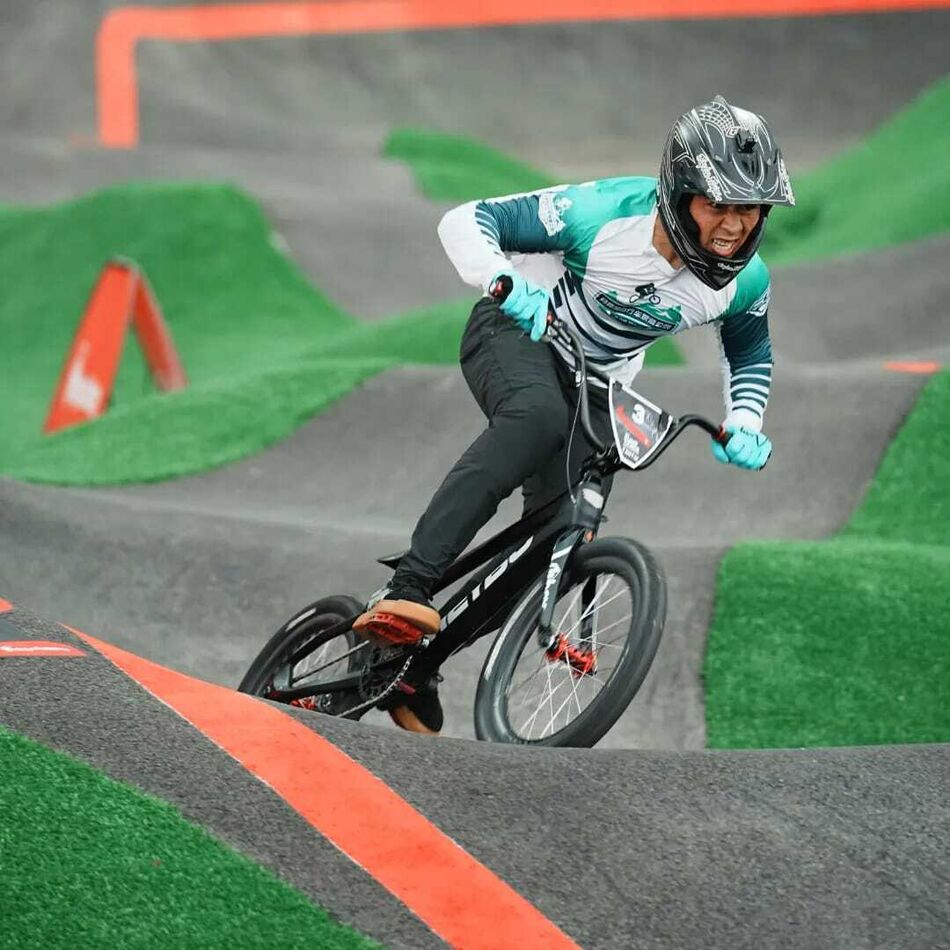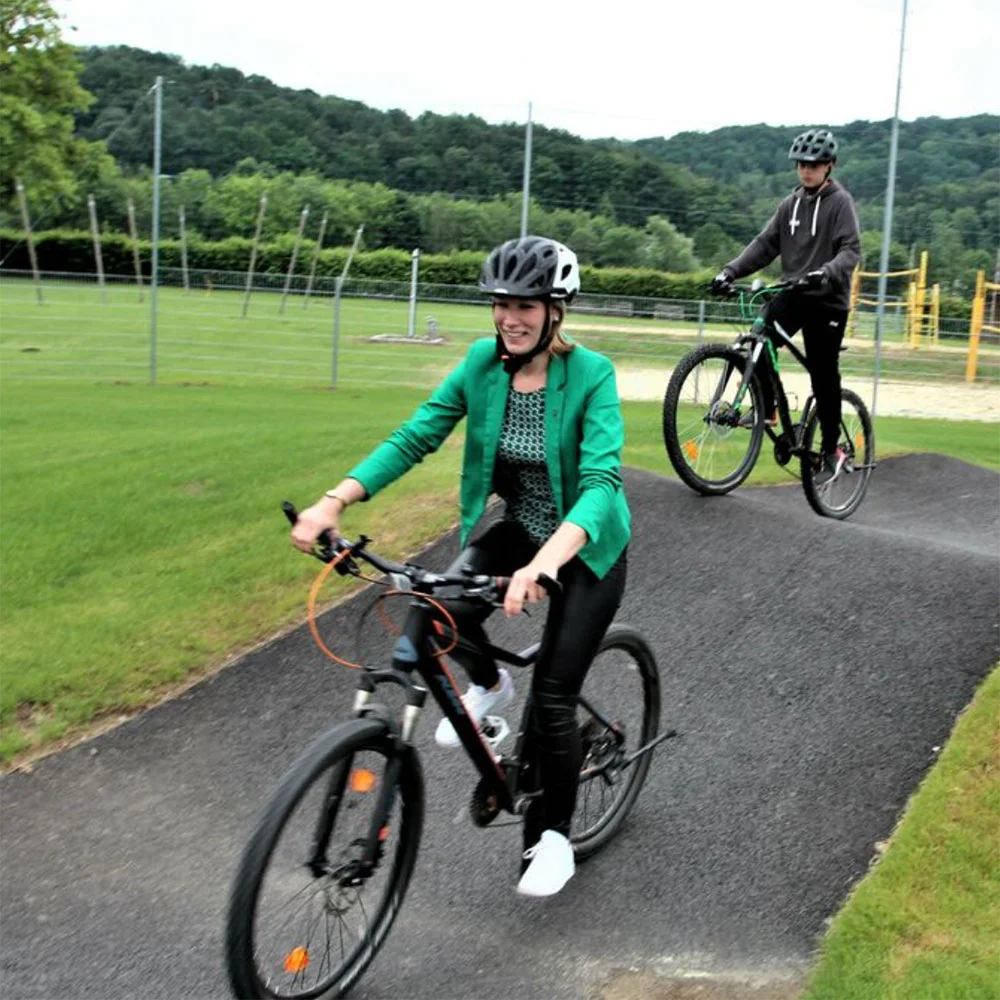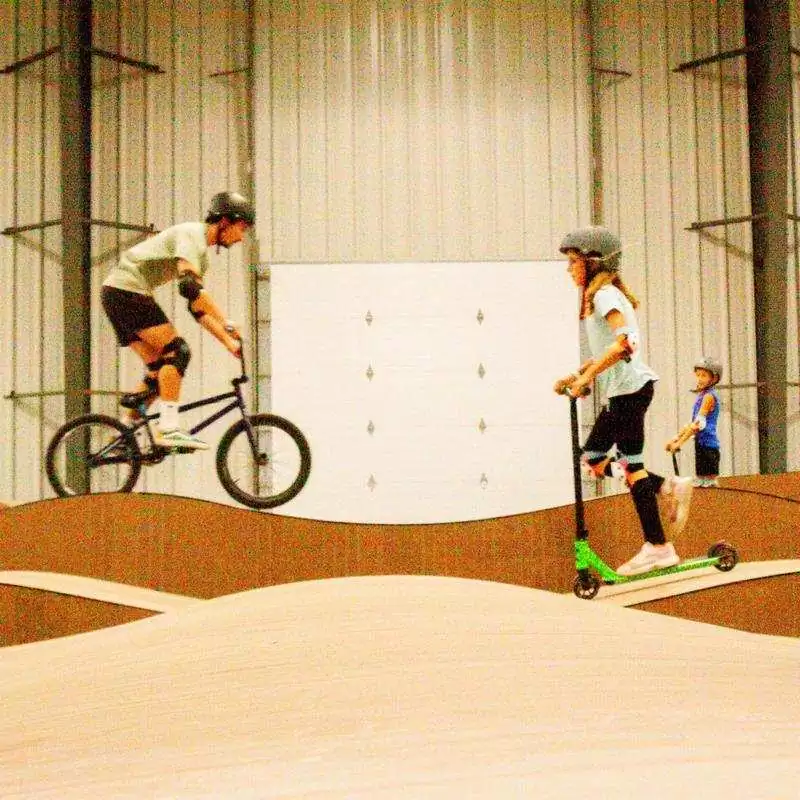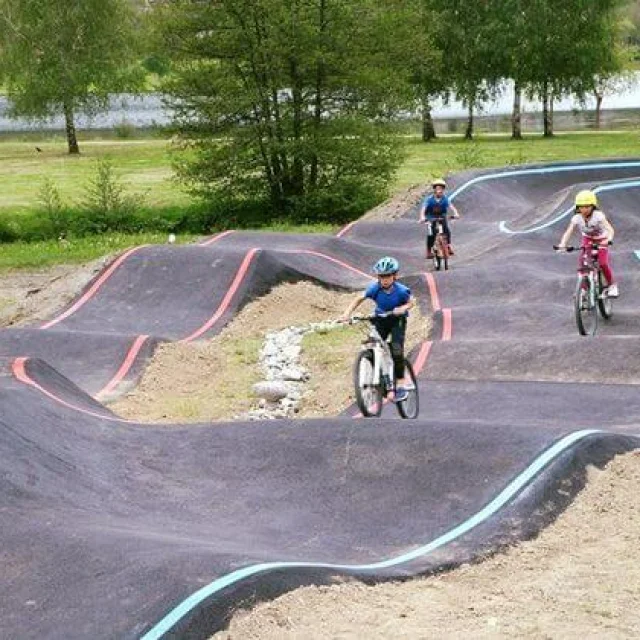I. Understanding Bicycle Pump Tracks

A. What is a Pump Track?
A bicycle pump track is a specially designed circuit with a series of rollers, banked turns, and other features, allowing riders to propel themselves through the track using momentum generated by pumping their arms and legs, rather than pedaling. The track’s design encourages riders to utilize body movements to maintain speed and flow, creating an exhilarating riding experience.
Pump tracks come in various shapes and sizes, from compact backyard tracks to larger public facilities, catering to riders of all ages and skill levels. They are designed to offer a fun and challenging environment for cyclists to improve their bike-handling skills, agility, and overall riding technique.
B. Benefits of Riding a Pump Track
Riding a pump track offers numerous benefits for cyclists of all levels. One of the primary advantages is the enhancement of bike-handling skills. Negotiating the banked turns, rollers, and small jumps within a pump track helps riders to develop essential techniques, including body positioning, balance, and cornering, which are transferable to other cycling disciplines such as mountain biking and BMX.
Additionally, pump track riding provides an excellent cardiovascular workout, as it demands continuous exertion and full-body engagement to maintain speed and momentum. The repetitive nature of pumping and navigating the track also contributes to muscle toning, core strength, and improved overall fitness.
Moreover, pump tracks foster a sense of community among riders, providing a social and inclusive environment for cyclists to connect, share tips, and inspire each other to improve their riding skills. From a broader perspective, pump tracks contribute to promoting cycling as an accessible and engaging recreational activity, encouraging people to embrace an active and healthy lifestyle.
II. Developing Skills on the Pump Track
A. Body Position and Technique
Mastering the art of pump track riding begins with understanding and applying proper body positioning and technique. The key to navigating the track effectively lies in using body movements to generate momentum and maintain speed through the terrain features.
Maintaining a low and centered body position is crucial for stability and control. Riders should bend their elbows and knees, keeping their weight centered over the bike’s bottom bracket. This positioning allows for better absorption of bumps and allows the bike to move freely beneath the rider, facilitating smooth and agile maneuvering through the track’s undulations.
Furthermore, riders should focus on looking ahead and through the turns, which helps in anticipating the track’s features and maintaining a smooth riding line. As riders become more adept, they can start incorporating manual and pumping techniques to further optimize speed and flow through the track.
B. Speed Control and Pumps

Pump tracks emphasize the skill of pumping, which involves using body movements to generate speed and momentum without pedaling. As riders approach the rollers, they should compress their body into the bike as it enters the trough, then extend their body as they exit the trough, applying pressure with their feet and arms.
By mastering the timing and application of pumps, riders can efficiently convert potential energy into kinetic energy, propelling themselves forward with minimal effort. Additionally, learning how to modulate speed and control momentum through the track’s features is essential for maintaining flow and mastering more advanced riding lines.
Furthermore, riders can experiment with different pumping techniques, such as weight shifting and timing variations, to enhance their efficiency and accelerate through the track. Developing a nuanced understanding of speed control and pumps is fundamental to maximizing performance and enjoyment on pump tracks.
III. Choosing the Right Bike for Pump Track Riding
A. Bike Selection Considerations
When it comes to pump track riding, choosing the right bike is essential for the optimal riding experience. While various types of bikes can be utilized on pump tracks, certain features and characteristics make particular bikes more suitable for this purpose.
For pump track riding, a BMX bike is a popular choice due to its maneuverability, durability, and agility. BMX bikes are designed to handle the rigors of pump track riding, with their sturdy construction, small frame, and strong components. The shorter wheelbase and responsive handling of a BMX bike make it well-suited for navigating tight turns and negotiating the rollers and jumps commonly found on pump tracks.
However, mountain bikes, dirt jump bikes, and even some hybrid bikes can also be used for pump track riding. When selecting a bike, riders should consider factors such as frame size, handlebar width, and overall geometry to ensure that the bike is well-suited for the specific demands of the pump track.
B. Tire Pressure and Suspension Set-Up
Optimizing tire pressure and suspension set-up is crucial for maximizing performance and control on a pump track. In general, lower tire pressures are preferred for pump track riding as they offer better traction, improved handling, and enhanced shock absorption over the track’s features.
Riders should experiment with different tire pressures to find the right balance between grip and rolling resistance, taking into account factors such as rider weight, tire size, and track conditions. For most pump track applications, tire pressures ranging from 20-40 psi are commonly recommended, depending on tire width and rider preference.
IV. Safety Tips for Riding Pump Tracks

A. Protective Gear
Safety should always be a top priority when riding on a pump track, and wearing appropriate protective gear is crucial for minimizing the risk of injury. Essential protective gear for pump track riding includes a helmet, gloves, knee and elbow pads, and sturdy footwear.
A properly fitted helmet is vital for protecting the head in the event of a fall or collision. Riders should ensure that their helmet meets safety standards and fits securely, providing adequate coverage and protection. Gloves offer hand protection, improve grip, and reduce the risk of abrasions in case of a spill.
Knee and elbow pads are instrumental for shielding vulnerable joints from impacts and abrasions, particularly during crashes or when landing after jumps. These protective pads help cushion blows and reduce the risk of serious injury. Finally, sturdy, closed-toe footwear such as skate shoes or mountain biking shoes provide grip and ankle support, enhancing stability and reducing the risk of foot-related injuries.
B. Riding Etiquette and Track Courtesy
Respecting riding etiquette and demonstrating track courtesy are essential for creating a safe and enjoyable environment for all riders on the pump track. Riders should familiarize themselves with local track rules and guidelines, as well as any posted signage or regulations specific to the facility.
When riding on a pump track, it’s important to be mindful of other riders and prioritize sharing the track responsibly. Be aware of your surroundings, yield to riders on the track, and communicate your intentions when entering or exiting the course. Additionally, being respectful of other users, such as skateboarders or scooter riders, fosters a positive and inclusive atmosphere on the pump track.
Furthermore, avoiding reckless behavior, adhering to speed limits, and refraining from blocking the track unnecessarily are all critical aspects of proper track courtesy. By upholding these practices, riders contribute to a safer, more enjoyable experience for everyone using the pump track.
V. Training and Practice Strategies
In order to become proficient in any skill or activity, it is important to have a focused and effective training and practice strategy. This is especially true when it comes to building endurance and strength, as well as developing fluidity and flow in any physical activity.
A. Building Endurance and Strength
Building endurance and strength is essential for excelling in any physical activity or sport. Whether you are a runner, a dancer, a weightlifter, or a martial artist, having a strong and resilient body is crucial for performing at your best.
- Set Clear Goals: The first step in building endurance and strength is to set clear and achievable goals. Whether you want to run a marathon, lift a certain amount of weight, or perfect a difficult dance routine, having a specific goal in mind will give you something to strive for and measure your progress against.
- Create a Training Plan: Once you have established your goals, it is important to create a training plan that will help you gradually build your endurance and strength. This plan should include a combination of cardiovascular exercises, strength training, and flexibility work, tailored to your specific activity or sport.
- Consistency is Key: Building endurance and strength takes time and consistency. It is important to stick to your training plan and make regular exercise a priority in your daily routine. This will allow your body to adapt and become stronger over time.
- Cross-Training: In addition to specific training for your chosen activity, incorporating cross-training into your routine can help prevent injury and improve overall fitness. This could include activities such as swimming, cycling, or yoga, which provide a different type of challenge for your body.
- Recovery and Rest: It is important to remember that rest and recovery are essential components of building endurance and strength. Giving your body time to recover after intense training sessions will allow your muscles to repair and grow stronger.
B. Developing Fluidity and Flow
In addition to building endurance and strength, developing fluidity and flow is important for mastering any physical activity or performance. Whether you are a dancer, a martial artist, or a musician, having a sense of fluidity and grace in your movements can elevate your skill to the next level.
- Mind-Body Connection: Developing fluidity and flow starts with developing a strong mind-body connection. This means being aware of your body’s movements and positioning, and being able to control them with precision and intention.
- Practice Mindfulness: Practicing mindfulness and being present in the moment can help you develop fluidity and flow in your movements. This can be achieved through activities such as yoga, meditation, or simply focusing on your breath while practicing your activity.
- Embrace Creativity: Developing fluidity and flow is not just about perfecting technique, but also about embracing creativity and expression in your movements. This can involve experimenting with different styles, incorporating improvisation, and finding your own unique way of moving.
- Seek Feedback: In order to improve and refine your fluidity and flow, it is important to seek feedback from instructors, peers, or mentors. Constructive criticism and guidance can help you identify areas for improvement and further enhance your performance.
In conclusion, mastering the art of pump track riding offers riders an exciting opportunity to refine their skills, improve fitness, and connect with a vibrant cycling community. By understanding the fundamentals of body positioning, technique, and speed control, cyclists can unlock the full potential of pump tracks, elevating their riding experience and reaping the myriad physical and social benefits that these unique riding environments offer.
